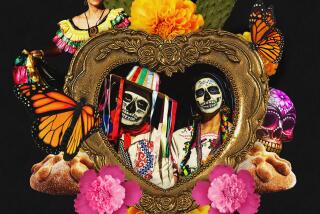L.A. Latinos celebrate a patron saint and a culture
It was just before midnight and downtown Los Angeles lay empty and silent, its streets subdued by the rain.
But on Spring Street, just around the corner from Cesar E. Chavez Avenue, the sidewalks teemed with humanity.
Crowds of pedestrians, many bearing bouquets, spilled into the road while a line of cars inched into a parking lot near Our Lady Queen of Angels Church across from Olvera Street. Vendors selling hot chocolate, tamales and votive candles stood over their steaming stands.
Flowers were piled in a pyramid in front of the mural of the Virgin Mary. Friday was the eve of Fiesta Guadalupana, a Catholic feast day celebrating the story of the Virgin Mary’s appearance to an Aztec Indian peasant in Mexico in 1531.
In spite of the cold, wet conditions over the weekend, thousands of worshipers flocked to the two-day celebrations, said Father Richard Estrada, an associate pastor at the church, which is also known as La Placita.
“It’s a shot in the arm of your culture, your faith,” Estrada said.
The Dec. 12 feast day holds special significance for Catholics of Mexican heritage.
Catholic tradition teaches that a peasant, Juan Diego, was walking over a hill called Tepeyac, a site linked to an ancient fertility goddess, when a brown-skinned woman appeared. She spoke in Nahuatl, language of the Aztecs, and asked that a church be built on the hill, which is near Mexico City.
For the faithful, the image of the Virgin of Guadalupe is more than symbol, Estrada said. “It’s real,” he said. “It is like a person that gives you strength and courage.”
Nearly 500 years after she is said to have appeared, the tradition is going strong on both sides of the border, said Father Paschal Amagba, another associate pastor of La Placita. On Saturday, the church held feast day Masses in Spanish and served hot chocolate and tamales to the crowds. Mariachi bands played outside.
“We celebrate as if it were in Mexico,” Amagba said. “When the people come here, they feel at home.”
On Friday night, Jorge Arcos carefully balanced a chest-high framed painting of the Virgin, which he and a friend had carried as they walked nine miles from Cudahy to the downtown celebrations. They wanted to have the picture blessed by a priest, Arcos said in Spanish.
“She blesses your work, your house, your family,” said the welder, 36. “We are Mexicans, and the Virgin has always been present in our lives.”
Around the church complex, bands played and people milled about, clutching paintings or statuettes of the Virgin. Maria Almaraz, 37, sat on a blanket, counting down the hours before the Mass at 4:30 a.m. Almaraz, of South Los Angeles, had come with her six sisters and five brothers and was surprised at the turnout, she said; even with the rain, it seemed better than in previous years. “Instead of dying out, I think we’ve hit a chord with people,” Estrada said.
His church has long served as a hub for Guadalupe feast day celebrants in the Los Angeles area.
The church has also been known for political activism. A sign outside the complex reads Madre sin fronteras -- mother without borders -- an allusion to immigration policy in the U.S.
The church uses each year’s feast day theme to convey a message, its priests said.
This year, they chose “Do not be afraid, I am with you.” They wanted to use the message to persuade illegal Latino immigrants to participate in the 2010 Census, Estrada said. “It’s important that everyone is counted,” the pastor said.
Estrada pointed to the plight of the poor and the undocumented in Los Angeles as reasons the story of the Virgin still resonates.
“These are the Juan Diegos,” Estrada said. “These are the poor and the people she really speaks to.
“Here in this church, it’s not purely religious. We don’t just say Mass and give confessions. We help organize people to treat themselves with dignity and express their culture.”
Among the visitors was Karla Partida, 23, who carried her sleepy toddler and a lacquered wood image of the Virgin that her family had picked up in Tijuana.
Her family had seen some difficult times, she said, but the Virgin had brought them blessings in many different ways.
She tried to explain the Virgin’s enduring appeal. “She represents that it doesn’t matter if you have money, doesn’t matter the race you are,” the young woman said.
“She doesn’t care. She loves everyone.”
More to Read
Sign up for Essential California
The most important California stories and recommendations in your inbox every morning.
You may occasionally receive promotional content from the Los Angeles Times.











